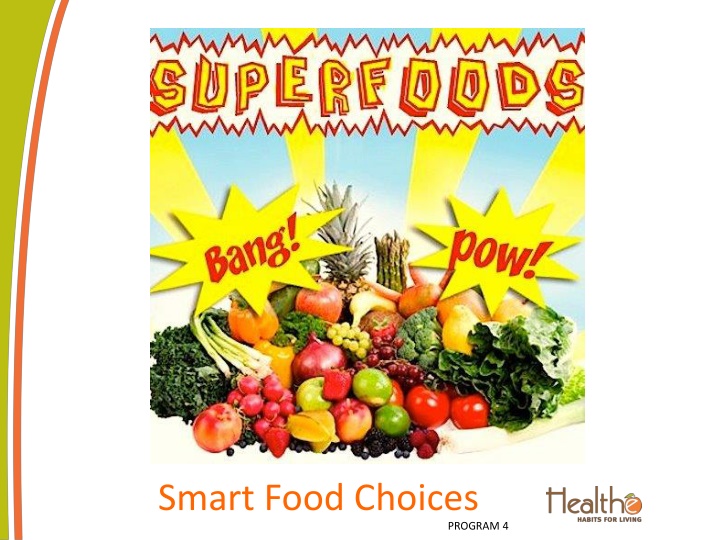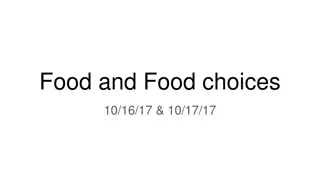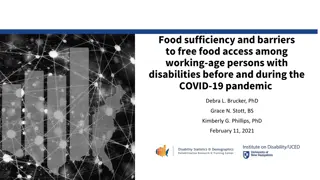Smart Food Choices
This program explores how superfoods like berries, nuts, and salmon can benefit your health with antioxidants, Omega-3 fatty acids, and other nutrients. Learn about reducing risks of diseases, improving mental health, and more through smart food choices.
Download Presentation

Please find below an Image/Link to download the presentation.
The content on the website is provided AS IS for your information and personal use only. It may not be sold, licensed, or shared on other websites without obtaining consent from the author.If you encounter any issues during the download, it is possible that the publisher has removed the file from their server.
You are allowed to download the files provided on this website for personal or commercial use, subject to the condition that they are used lawfully. All files are the property of their respective owners.
The content on the website is provided AS IS for your information and personal use only. It may not be sold, licensed, or shared on other websites without obtaining consent from the author.
E N D
Presentation Transcript
Smart Food Choices PROGRAM 4
Program 5: Tasty Food Choices Defining Superfoods Health Benefits of Superfoods Functional Foods Benefits of Low Glycemic Diet Carbohydrates: Pros & Cons
Program 5: Tasty Food Choices Superfoods 50-70 Percentage of health-related problems that could be eliminated by what people eat and how they move. . . -- Nutritionist & Author Elizabeth Somer maintain weight live longer fight disease
Program 5: Tasty Food Choices Superfoods Functional Foods -- foods or dietary components that may provide a health benefit beyond basic nutrition. tomatoes turkey oranges beans soy yogurt blueberries pumpkin oats salmon spinach broccoli walnuts tea
Program 5: Tasty Food Choices Super Foods The Top 10 Reasons for Super Foods Reduce Risk of Cardiovascular Diseases Reduce Risk of Other Diseases Reduce Risk of Cancer Reduce Osteoporosis Weight Loss / Management Improve Mental Health Improve Health in General Improve Reaction Time Improve Memory Improve Fetal Health
Program 4: Healthy Food Choices Superfoods Superfoods Berries High in Antioxidants Vitamin C Soluble fiber Broccoli( &cauliflower, cabbage, Brussel sprouts) Boosts immune system Cancer fighting properties High in fiber, low in calories Citrus High in Antioxidants Anti-inflammatory Inhibits Blood clotting Anti-cancer Garlic Lowers Blood Pressure Decreased LDL (bad cholesterol) Inhibits Blood clotting Increases HDH (good cholesterol)
Program 4: Healthy Food Choices Superfoods Superfoods Nuts High in Omega 3 fatty acids Lowers LDL levels High in fiber and protein Oats Reduce cholesterol (one bowl/day reduces cholesterol by 23%) High in fiber, low in calories Less blood sugar fluctuations compared to other grains Salmon (and other cold water fish) High in Omega 3 fatty acids Inhibits Blood clotting Fights heart disease Spinach and Kale Contains Lutein (prevents cataracts and macular degeneration) High in fiber and low in calories Contains chlorophyll (cancer fighter)
Program 4: Healthy Food Choices Superfoods Superfoods Tomatoes Contain high levels of Lycopene (powerful antioxidant) Vitamins A and C Low in calories Turkey Contains Selenium (aids in metabolism of thyroid hormone) Improves immune system Very lean protein Flax and Chia Seeds High in Omega 3 fatty acids Fights heart disease High in fiber and protein - slows digestion Beans High in fiber, protein, complex carbs Cancer fighting antioxidants Fill you up quickly
Program 4: Healthy Food Choices Superfoods Superfoods Soy High in protein High is fiber High isoflavones (positive effect on cognition) Pumpkin Contains beta-carotene (lowers heart disease and cancer) High in Vitamin C, E, magnesium, potassium High in fiber Yogurt High in protein (especially Greek) Contains Probiotics (improves immune system) High in calcium, B vitamins.
Program 5: Tasty Food Choices Super Foods super foods diet Incorporating Superfoods Eat a balanced diet with a variety of foods from each food group, then include specific superfoods with beneficial components to meet your individual needs. Consult with your health care provider before making any drastic changes in your diet or if you have a particular health concern.
Program 5: Tasty Food Choices Super Foods Can I believe what I read about the benefits of functional foods? It depends on the source: Be wary of single-study reports promote benefit of eating a certain food. When collecting information from television, radio, newspapers, and the internet, make sure the source is credible. When in doubt, check with a dietician or healthcare provider Remember that success stories of friends and family do not mean that the same practices will work for you.
Carbohydrates Made up of 3 components Fiber Sugar Starch The ratio of these components is what determines a good vs bad carb
Program 5: Tasty Food Choices Carbohydrates Complex Carbohydrates Also known as Good Carbs Higher concentration of fiber, and lower in starch and sugar Digested more slowly, helping you feel fuller longer Found in more healthy foods, like most vegetables, fruits , whole grains Lower in calories Aid weight management Contain other nutritional benefits, such as vitamins, minerals, phytochemicals, and other nutrients rarely found simple carbs.
Program 5: Tasty Food Choices Carbohydrates Simple Carbohydrates Also known as Bad Carbs Simple sugars quickly converted to glucose Found in refined and processed foods, including white breads, white rice, pasta, sugary beverages, and candy. Linked to multiple diseases, diabetes, and insulin resistance Cause blood sugar levels to spike quickly
Program 5: Tasty Food Choices Low Glycemic Diets Glycemic Index (GI) - a ranking that determines how carbohydrates in certain foods affect the blood glucose levels. Glycemic index of 70+ is considered a high glycemic food Glycemic index of 55 - 70 is moderate glycemic food; normal Glycemic index of <55 is low glycemic food Low GI foods: Produce only small fluctuations in blood glucose and insulin levels Reduce the risk of disease and diabetes Promote sustainable weight loss Aid in improving body functions of the skin, heart, digestion, and immune system just to name a few























